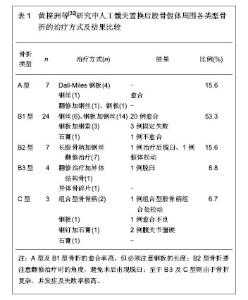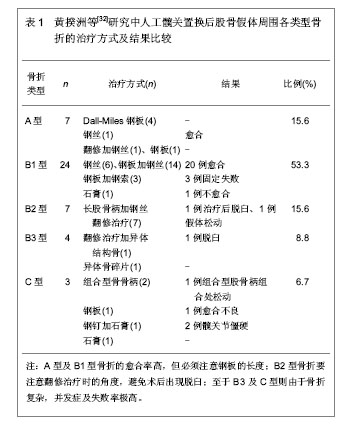Chinese Journal of Tissue Engineering Research ›› 2013, Vol. 17 ›› Issue (30): 5557-5562.doi: 10.3969/j.issn.2095-4344.2013.30.022
Previous Articles Next Articles
Fractures around femoral prosthesis after artificial hip replacement
Liu Ying-fei, Wang Tao, Zhang Ping-de
- Department of Orthopedics, Second Affiliated Hospital of Hebei North University, Zhangjiakou 075100, Hebei Province, China
-
Received:2013-01-18Revised:2013-05-27Online:2013-07-23Published:2013-07-23 -
About author:Liu Ying-fei, Associate chief physician, Department of Orthopedics, the Second Affiliated Hospital of Hebei North Univeristy, Zhangjiakou 057000, Hebei Province, China liuyingfei1900@yahoo.com.cn
CLC Number:
Cite this article
Liu Ying-fei, Wang Tao, Zhang Ping-de . Fractures around femoral prosthesis after artificial hip replacement [J]. Chinese Journal of Tissue Engineering Research, 2013, 17(30): 5557-5562.
share this article

2.1 人工髋关节置换后股骨假体周围骨折的原因 股骨假体周围骨折可能与多种因素有关,主要包括以下几点: 2.1.1 年龄性别因素导致的骨质疏松 进行关节置换患者大多数为老年人,且原发疾病多为骨关节炎、类风湿关节炎等,加之因疼痛而活动量减少,均不同程度存在骨质疏松,容易导致低能量骨折[18]。Franklin等[19]研究认为女性高龄是人工髋关节置换后股骨假体周围骨折发生的独立危险因素。目前骨质疏松是公认的股骨假体周围骨折的危险因素,其引起的骨机械力的降低,易导致骨折发生[20]。 2.1.2 假体的选择与固定方式 国内外文献报道股骨假体周围骨吸收的情况大部分采用定性判定[21-22],很少注意到骨水泥型和非骨水泥型的人工髋关节的选择对股骨假体周围骨密度的影响[23]。相关报道骨水泥型假体的股骨假体周围骨折的发生率为0.1%-3.2%,而非骨水泥型假体的股骨假体周围骨折的发生率为3%-28%,后者明显高于前者[24]。Tsiridis等[25]报道人工髋关节置换采用骨水泥型假体固定者治疗后发生股骨假体周围骨折的发病率为6.3%,行非骨水泥型假体固定者为17.6%。这与选择非骨水泥型假体时,期望假体与股骨有完美的匹配,而在选择假体时过分追求柄与股骨的紧密配合而使用过粗的股骨柄,在强行打入髓腔锉或在扩髓不充分的情况下打入股骨假体导致骨折有关。 2.1.3 基础疾病[26] 有广泛或局部骨溶解的患者,如假体松动,假体的末端会撞击外侧骨皮质,使局部应力增加,在轻微外力下即可造成骨折[27]。人工髋关节翻修患者常有骨量不足,可能导致假体固定困难,取出假体及骨水泥时需行股骨皮质开窗等,这些都会引起皮质损伤,从而降低股骨强度。另外,还有学者发现翻修次数越多,股骨假体周围骨折风险也越大。 2.1.4 股骨假体周围骨密度变化 股骨假体周围骨密度变化对假体置换的疗效影响较大,因为它显著影响假体的初始稳定,而假体的初始稳定是骨长入微孔的重要前提,而骨长入微孔又是假体长期稳定的保证。人工髋关节置换有骨水泥固定型与非骨水泥固定型两种,二者对股骨假体周围骨密度变化的影响有各自的特点。 骨水泥固定型对假体周围骨密度的影响:①骨水泥固定增加了碎屑,生物性因素引起的骨溶解在骨水泥固定中起的作用大。②骨水泥固定的假体置换后即时固定效果,相对于非骨水泥固定存在的早期假体微动和下沉问题,骨水泥固定的假体在骨组织-骨水泥-假体界面上没有任何微动发生,允许置换后早期负重。③骨水泥假体价格比非骨水泥型假体要低。 非骨水泥固定型对假体周围骨密度的影响:①非骨水泥假体为达到骨组织长入的良好初始固定效果,要求之一是柄体能很好的充填骨髓、紧密嵌插,这使得非骨水泥固定型股骨柄假体多较骨水泥固定型粗大,无形中增加了假体的刚性,这也是非骨水泥假体应力遮挡现象严重,容易出现柄体远端大腿痛的原因。②通过骨长入来达到生物固定的人工关节,对置换结束要求较高,应避免早起下肢负重,所以对于高龄或者严重骨质疏松的患者,不宜使用非骨水泥固定人工假体。③非骨水泥假体置换后,患者跛行,疼痛、假体松动和返修率高。④一旦出现松动,在返修治疗中骨的缺失量可能比骨水泥型假体要少,需要的植骨量也少,因此,主张对年纪较轻的患者首选非骨水泥固定型假体。⑤髋臼侧非骨水泥假体置换后效果要好于骨组织长入骨水泥固定型髋臼假体,尤其是患者年轻和人工髋关节置换返修患者,骨组织长入主要发生于假体与自体骨紧密接触区域,移植骨处不发生改现象,骨组织长入在髋臼侧要明显高于股骨侧。 2.1.5 其他因素 外伤或摔倒,绝大多数是微小创伤,如扭伤或摔伤,高能量创伤占少数,Beals等[28]报道,人工髋关节置换后发生股骨假体周围骨折66%是在室内摔倒所致,18%是在室外摔倒所致,仅有8%由较大创伤所致,其余8%为自发性骨折。人工髋关节置换后肢体负重增加引起的疲劳性骨折,不正确的功能锻炼,进行关节置换患者平均年龄较大,肌肉力量、身体协调性明显下降,治疗后常无法正确、科学的进行肌肉和关节活动度的训练,躯体稳定性及关节活动度差,容易出现意外损伤。 2.2 人工髋关节置换后股骨假体周围骨折的治疗 股骨假体周围骨折的治疗目标是使骨折稳定在解剖位置上并获骨性愈合,假体牢固稳定避免松动,尽早开始功能锻炼。股骨假体周围骨折的治疗方法有很多种,包括保守治疗如牵引、石膏或支具等[29]。手术治疗如钢丝钢缆环扎、钢板、异体皮质骨骨板、髓内钉、长柄骨水泥型或非骨水泥型假体翻修联合或不联合使用植骨等。在治疗人工髋关节置换后股骨假体周围骨折时要兼顾骨折、假体及骨量3个方面。相关研究表明移位的骨折需要进行内固定,松动的假体需要翻修,骨缺损明显者需要植骨[30-31]。对假体松动的股骨骨折进行内固定的同时进行翻修已达成共识,使用长柄非骨水泥远端固定型假体联合异体皮质骨板来处理假体松动的股骨骨折,被认为是常规应采用的治疗方法[32]。 黄揆洲等[33]探讨了人工髋关节置换后假体柄周围股骨骨折的治疗计划以及临床效果。将45例患者,依Vancouver分类系统,共有7例A型骨折,24例B1型骨折,7例B2型骨折,4例B3型骨折以及3例C型骨折。分别根据假体稳定度作骨折内固定或人工髋关节翻修治疗,应用钢板加钢丝或钢索、Dall-Miles钢板、异体结构骨、异体骨碎片等,翻修治疗应用常规骨柄或组合式股骨柄,并分析人工髋关置换后股骨假体周围各类型骨折及各种治疗方式的结果与并发症,结果见表1。"

| [1] Abendschein W.Periprosthetic femur fractures--a growing epidemic.Am J Orthop (Belle Mead NJ).2003;32(9):34-36.[2] J Arthroplasty.Common threads in hip, knee, and shoulder arthroplasty.J Arthroplasty.2002;17(4):2.[3] Tsiridis E,Haddad FS,Gie GA.The management of periprosthetic femoral fractures around hip replacements. Injury. 2003;34(2):95-105.[4] Berend ME,Smith A,Meding JB,et al.Long-term outcome and risk factors of proximal femoral fracture in uncemented and cemented total hip arthroplasty in 2551 hips.J Arthroplasty. 2006;21(6):53-59.[5] Singh JA,Jensen MR,Lewallen DG.Patient factors predict periprosthetic fractures after revision total hip arthroplasty.J Arthroplasty.2012;27(8):1507-1512.[6] Berry DJ.Management of periprosthetic fractures: the hip.J Arthroplasty.2002;17(4):11-13.[7] Zuurmond RG,Pilot P,Verburg AD,et al.Retrograde bridging nail in periprosthetic femoral fracture treatment which allows direct weight bearing.Proc Inst Mech Eng H.2008; 222(5): 629-635.[8] Zuurmond RG,Pilot P,Verburg AD.Retrograde bridging nailing of periprosthetic femoral fractures.Injury. 2007; 38(8):958-964.[9] Masri BA,Meek RM,Duncan CP.Periprosthetic fractures evaluation and treatment.Clin Orthop Relat Res.2004; (420): 80-95.[10] Duncan CP,Masri BA.Fractures of the femur after hip replacement.Instr Course Lect.1995;44:293-304.[11] Adolphson P,Jonsson U,Kalén R.Fractures of the ipsilateral femur after total hip arthroplasty.Arch Orthop Trauma Surg. 1987;106(6):353-357.[12] Mallory TH,Lombardi AV Jr,Fada RA,et al.Dislocation after total hip arthroplasty using the anterolateral abductor split approach.Clin Orthop Relat Res.1999;(358):166-172.[13] Mitchell PA,Greidanus NV,Masri BA,et al.The prevention of periprosthetic fractures of the femur during and after total hip arthroplasty.nstr Course Lect.2003;52:301-308.[14] Hou Z,Moore B,Bowen TR,et al.Treatment of interprosthetic fractures of the femur.J Trauma.2011;71(6):1715-1719.[15] Della Valle CJ,Momberger NG,Paprosky WG.Periprosthetic fractures of the acetabulum associated with a total hip arthroplasty.Instr Course Lect.2003;52:281-290.[16] 中国知网.中国学术期刊总库[DB/OL].2013-3-27. https://www.cnki.net[17] SCI数据库.Web of Sciencevia ISI Web of Knowledge[DB/OL]. 2013-3-27.http://ip-science.thomsonreuters.com/mjl[18] 庞贵根,张涛.全髋关节置换术后股骨假体周围骨折的分类和治疗进展[J].中国矫形外科杂志,2006,14(13):995-997.[19] Franklin J,Malchau H.Risk factors for periprosthetic femoral fracture.Injury.2007;38(6):655-660.[20] Lindahl H,Garellick G,Regnér H,et al.Three hundred and twenty-one periprosthetic femoral fractures.J Bone Joint Surg Am.2006;88(6):1215-1222.[21] 林荔军,靳安民,方国芳,等.全髋关节表面置换术后股骨侧应力分布的有限元分析[J].中国临床解剖学杂志,2008,26(4):426-428.[22] Yamaguchi K,Masuhara K,Ohzono K,et al.Evaluation of periprosthetic bone-remodeling after cementless total hip arthroplasty. The influence of the extent of porous coating.J Bone Joint Surg Am.2000;82(10):1426-1431.[23] Wilkinson JM,Peel NF,Elson RA,et al.Measuring bone mineral density of the pelvis and proximal femur after total hip arthroplasty.J Bone Joint Surg Br.2001;83(2):283-288.[24] 杨德炎,李永斌,黎忠文,等.形状记忆环抱接骨板治疗全髋关节置换术后股骨假体周围骨折[J].中国骨与关节损伤杂志,2011, 26(8): 732-733.[25] Tsiridis E,Haddad FS,Gie GA.The management of periprosthetic femoral fractures around hip replacements. njury.2003;34(2):95-105.[26] Lindahl H,Oden A,Garellick G,et al.The excess mortality due to periprosthetic femur fracture. A study from the Swedish national hip arthroplasty register.Bone.2007;40(5):1294-1298.[27] Davidson D,Pike J,Garbuz D,et al.Intraoperative periprosthetic fractures during total hip arthroplasty. Evaluation and management.J Bone Joint Surg Am.2008; 90(9):2000-2012.[28] Beals RK,Tower SS.Periprosthetic fractures of the femur. An analysis of 93 fractures.Clin Orthop Relat Res.1996;(327): 238-246.[29] Kavanagh BF.Femoral fractures associated with total hip arthroplasty.Orthop Clin North Am.1992;23(2):249-257.[30] Lewallen DG,Berry DJ.Periprosthetic fracture of the femur after total hip arthroplasty: treatment and results to date.Instr Course Lect.1998;47:243-249.[31] 许锐雄,钟昌戎,朱亚波,等.两种内固定治疗全髋关节置换术后继发股骨假体周围骨折临床观察[J].现代诊断与治疗,2012, 23(4): 343-344.[32] 赵帅,陈富强,沈珊安,等.间接复位锁定加压钢板结合钢缆治疗髋关节置换术后VanCouver B1型股骨假体周围骨折[J].中国骨与关节损伤杂志,2010,25(8):713-714.[33] 黄揆洲.人工髋关节置换术后假体柄周围股骨骨折的治疗[J].中华关节外科杂志,2009,3(5):581-586.[34] Schwartz JT Jr,Mayer JG,Engh CA.Femoral fracture during non-cemented total hip arthroplasty.J Bone Joint Surg Am. 1989;71(8):1135-1142. |
| [1] | Xu Feng, Kang Hui, Wei Tanjun, Xi Jintao. Biomechanical analysis of different fixation methods of pedicle screws for thoracolumbar fracture [J]. Chinese Journal of Tissue Engineering Research, 2021, 25(9): 1313-1317. |
| [2] | Zhang Tongtong, Wang Zhonghua, Wen Jie, Song Yuxin, Liu Lin. Application of three-dimensional printing model in surgical resection and reconstruction of cervical tumor [J]. Chinese Journal of Tissue Engineering Research, 2021, 25(9): 1335-1339. |
| [3] | Zhang Chong, Liu Zhiang, Yao Shuaihui, Gao Junsheng, Jiang Yan, Zhang Lu. Safety and effectiveness of topical application of tranexamic acid to reduce drainage of elderly femoral neck fractures after total hip arthroplasty [J]. Chinese Journal of Tissue Engineering Research, 2021, 25(9): 1381-1386. |
| [4] | Chen Xinmin, Li Wenbiao, Xiong Kaikai, Xiong Xiaoyan, Zheng Liqin, Li Musheng, Zheng Yongze, Lin Ziling. Type A3.3 femoral intertrochanteric fracture with augmented proximal femoral nail anti-rotation in the elderly: finite element analysis of the optimal amount of bone cement [J]. Chinese Journal of Tissue Engineering Research, 2021, 25(9): 1404-1409. |
| [5] | Du Xiupeng, Yang Zhaohui. Effect of degree of initial deformity of impacted femoral neck fractures under 65 years of age on femoral neck shortening [J]. Chinese Journal of Tissue Engineering Research, 2021, 25(9): 1410-1416. |
| [6] | Zhang Shangpu, Ju Xiaodong, Song Hengyi, Dong Zhi, Wang Chen, Sun Guodong. Arthroscopic suture bridge technique with suture anchor in the treatment of acromioclavicular dislocation [J]. Chinese Journal of Tissue Engineering Research, 2021, 25(9): 1417-1422. |
| [7] | Zhang Chao, Lü Xin. Heterotopic ossification after acetabular fracture fixation: risk factors, prevention and treatment progress [J]. Chinese Journal of Tissue Engineering Research, 2021, 25(9): 1434-1439. |
| [8] | Zhou Jihui, Li Xinzhi, Zhou You, Huang Wei, Chen Wenyao. Multiple problems in the selection of implants for patellar fracture [J]. Chinese Journal of Tissue Engineering Research, 2021, 25(9): 1440-1445. |
| [9] | Wang Debin, Bi Zhenggang. Related problems in anatomy mechanics, injury characteristics, fixed repair and three-dimensional technology application for olecranon fracture-dislocations [J]. Chinese Journal of Tissue Engineering Research, 2021, 25(9): 1446-1451. |
| [10] | Chen Junming, Yue Chen, He Peilin, Zhang Juntao, Sun Moyuan, Liu Youwen. Hip arthroplasty versus proximal femoral nail antirotation for intertrochanteric fractures in older adults: a meta-analysis [J]. Chinese Journal of Tissue Engineering Research, 2021, 25(9): 1452-1457. |
| [11] | Hu Kai, Qiao Xiaohong, Zhang Yonghong, Wang Dong, Qin Sihe. Treatment of displaced intra-articular calcaneal fractures with cannulated screws and plates: a meta-analysis of 15 randomized controlled trials [J]. Chinese Journal of Tissue Engineering Research, 2021, 25(9): 1465-1470. |
| [12] | Xu Yulin, Shen Shi, Zhuo Naiqiang, Yang Huilin, Yang Chao, Li Yang, Zhao Heng, Zhao Lu. Biomechanical comparison of three different plate fixation methods for acetabular posterior column fractures in standing and sitting positions [J]. Chinese Journal of Tissue Engineering Research, 2021, 25(6): 826-830. |
| [13] | Cai Qunbin, Zou Xia, Hu Jiantao, Chen Xinmin, Zheng Liqin, Huang Peizhen, Lin Ziling, Jiang Ziwei. Relationship between tip-apex distance and stability of intertrochanteric femoral fractures with proximal femoral anti-rotation nail: a finite element analysis [J]. Chinese Journal of Tissue Engineering Research, 2021, 25(6): 831-836. |
| [14] | Hou Guangyuan, Zhang Jixue, Zhang Zhijun, Meng Xianghui, Duan Wen, Gao Weilu. Bone cement pedicle screw fixation and fusion in the treatment of degenerative spinal disease with osteoporosis: one-year follow-up [J]. Chinese Journal of Tissue Engineering Research, 2021, 25(6): 878-883. |
| [15] | He Li, Tian Wei, Xu Song, Zhao Xiaoyu, Miao Jun, Jia Jian. Factors influencing the efficacy of lumbopelvic internal fixation in the treatment of traumatic spinopelvic dissociation [J]. Chinese Journal of Tissue Engineering Research, 2021, 25(6): 884-889. |
| Viewed | ||||||
|
Full text |
|
|||||
|
Abstract |
|
|||||